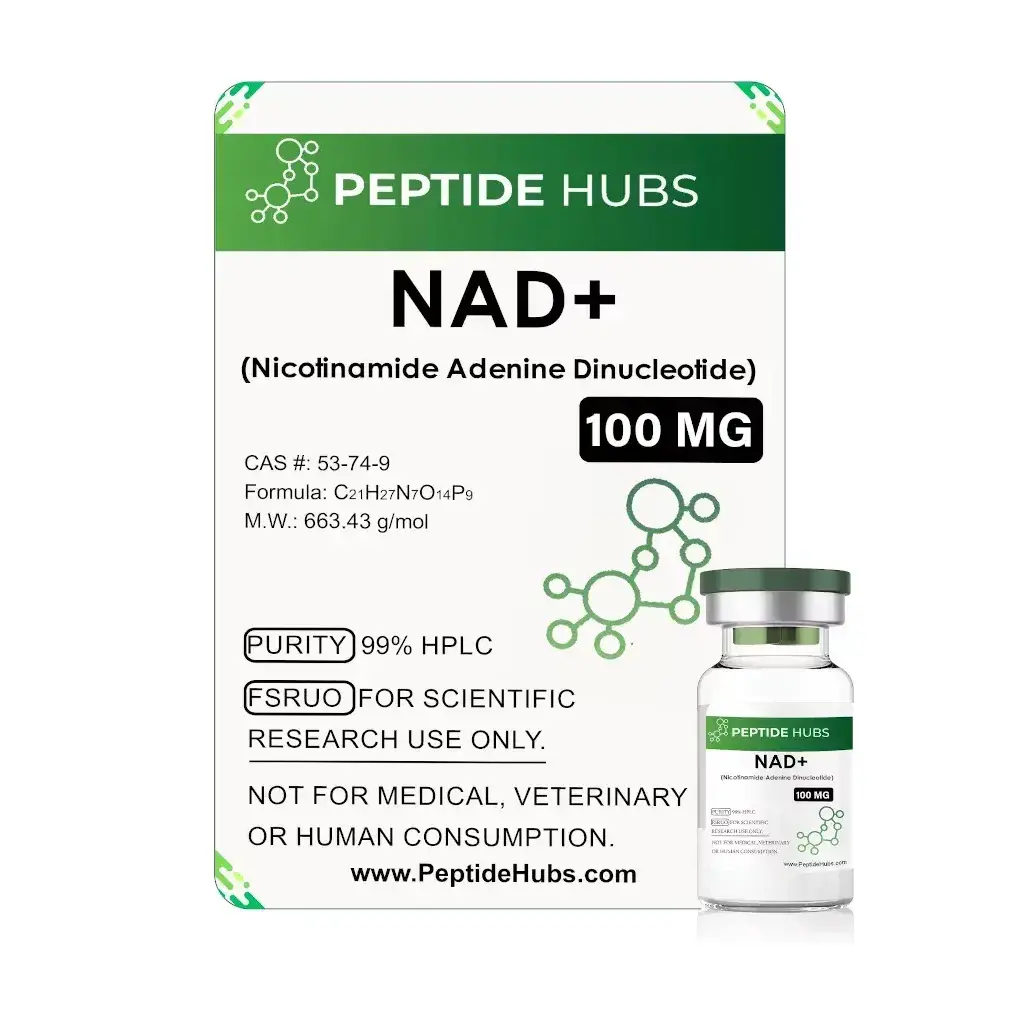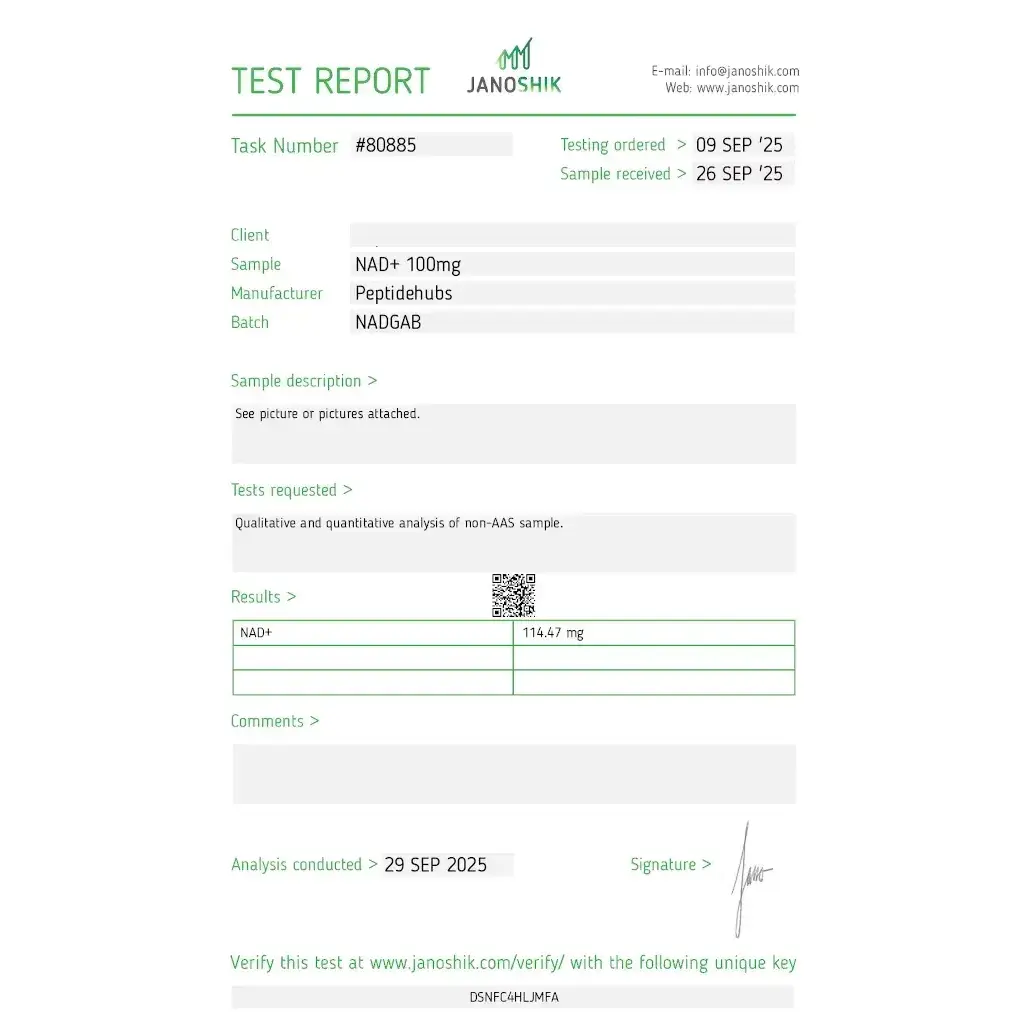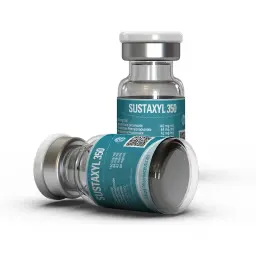



Drug Class: Essential Coenzyme / Nucleotide
Composition: Nicotinamide Adenine Dinucleotide
Dosage: 100 mg/vial
Form: Lyophilized (Freeze-Dried) Powder
Unit: 2 mL Vial
Brand: Peptide Hubs
Laboratory Test: View Lab Report
For Research and Laboratory Use Only
Nicotinamide Adenine Dinucleotide (NAD+) is not just another supplement; it is a fundamental coenzyme present in every single cell of your body, essential for life itself. As the central conductor of cellular metabolism, NAD+ levels profoundly influence energy production, DNA repair, and the aging process. Peptide Hubs offers a high-purity 100 mg vial of NAD+ in lyophilized form, providing researchers with a direct method to study the impact of elevating this critical molecule on physical performance, cognitive function, and overall cellular health.
NAD+ is a crucial coenzyme found in all living cells. It exists in two forms: NAD+ (oxidized) and NADH (reduced). This dynamic duo acts as a shuttle bus for electrons, playing a pivotal role in redox reactions, most notably in the mitochondria during cellular respiration. Here, it helps convert nutrients from food into adenosine triphosphate (ATP), the primary energy currency of the cell. Beyond energy metabolism, NAD+ serves as a essential substrate for several key enzymes, including sirtuins (SIRTs), which are proteins linked to longevity and DNA repair, and poly (ADP-ribose) polymerases (PARPs), which are critical for DNA repair. The decline of NAD+ with age is considered a hallmark of the aging process, contributing to reduced energy, slower recovery, and increased susceptibility to age-related diseases. For a foundational scientific overview, refer to the NAD+ compound summary on PubChem.
Elevating NAD+ levels through supplementation can have wide-ranging, systemic effects that are highly relevant to athletes and anyone seeking to optimize their health and performance.
NAD+ is typically reconstituted with Bac Water and is most effectively administered via intramuscular (IM) or subcutaneous (SubQ) injection for research purposes. Intravenous administration is used clinically but is not practical for most research settings.
NAD+'s fundamental role in cellular function makes it an excellent foundational component in a research stack, synergizing with peptides that target specific pathways like growth hormone, metabolism, and cellular repair.
NAD+ is generally well-tolerated, especially when started at a moderate dose. Most side effects are mild and transient.
Your Peptide Hubs NAD+ 100 mg vial arrives as a lyophilized powder. To reconstitute, gently inject 2-3 mL of Bacteriostatic Water into the vial, aiming the stream against the glass wall. Roll the vial gently between your hands until the powder is fully dissolved and the solution is clear. Do not shake vigorously, as this can potentially degrade the molecule. Once reconstituted, the solution must be refrigerated and used within a few weeks. Unreconstituted vials should be stored in a refrigerator, protected from light, to ensure long-term stability of this sensitive molecule.
Name: Nicotinamide Adenine Dinucleotide
Drug Class: Essential Coenzyme / Nucleotide
Other common names and terms: NAD, Coenzyme 1, Oxidized Nicotinamide Adenine Dinucleotide
Active Life: Several hours (exact half-life in circulation is short, but cellular effects are sustained)
Detection Time: Not established; likely very short.
Chemical Structure: C21H27N7O14P2
Common Doses: 50-200 mg, 2-3 times per week
Blood pressure: No significant negative impact; may have a beneficial effect.
Acne: No
Water retention: No
Aromatisation: No (does not convert to estrogen)
Liver toxicity: No evidence of hepatotoxicity; is hepatoprotective.
Decrease HPTA function: No
NMN (Nicotinamide Mononucleotide) and NR (Nicotinamide Riboside) are both precursors to NAD+. This means your body must convert them into NAD+ through enzymatic processes. Direct NAD+ supplementation bypasses these conversion steps, delivering the active coenzyme directly to cells. While all three can raise NAD+ levels, direct NAD+ administration may lead to a more rapid and potent increase, especially in tissues where precursor conversion is less efficient.
This is a common, transient reaction often referred to as a "niacin-like flush." It occurs because NAD+ can be broken down into nicotinamide, which activates certain receptors in the skin (GPR109A), causing blood vessels to dilate. This reaction is generally harmless and subsides within 15-30 minutes. Slowing the injection rate (if administered via a slow IV push in a clinical setting) or starting with a lower dose can help mitigate this effect.
Yes, NAD+ can be a valuable adjunct in a PCT protocol. The stress of a cycle and the subsequent recovery process are highly demanding on cellular energy and repair systems. By boosting ATP production, reducing oxidative stress, and supporting DNA repair via sirtuin activation, NAD+ can help accelerate systemic recovery, improve mood and cognitive function, and support the body's natural hormonal reboot, making the PCT phase more effective and tolerable.
The lab result of 114.47 mg indicates a significant overfill, which is a standard practice for high-quality manufacturers to ensure you receive at least the advertised 100 mg of active NAD+. This overfill accounts for potential minor loss during the reconstitution and administration process and confirms Peptide Hubs' commitment to providing full value and a potent, accurately dosed product for research purposes.
Both routes are used in research, but Intramuscular (IM) injection is generally preferred for larger volumes and may offer slightly better bioavailability for NAD+. The muscle tissue has a rich blood supply, facilitating rapid absorption into the bloodstream. Subcutaneous (SubQ) injection is also effective and may be preferred for its ease and comfort, though absorption can be slightly slower. The choice often comes down to researcher preference and tolerance for injection site discomfort.
Please log in to write NAD+ 100 mg review.

For Intramuscular Injection
Composition:
- Testosterone Propionate 42 mg
- Testosterone Phenylropionate 84 mg
- Testosterone Isocaproate 84 mg
- Testosterone Decanoate 140 mg
Mixed Dosage: 350 mg/1 mL
Unit: 10 mL Multidose Vial
Manufactured by Kalpa Pharmaceuticals